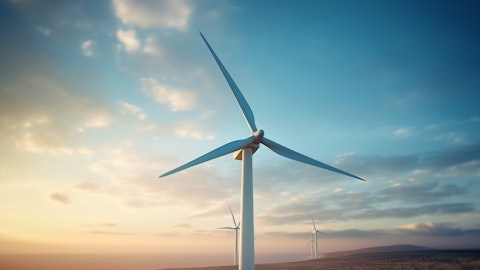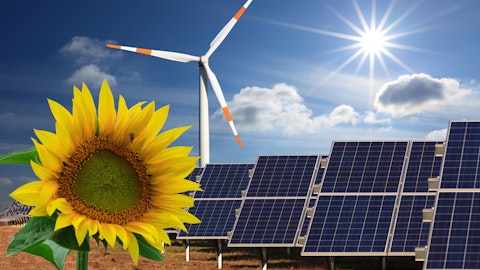Justin Clare: Yes, hi. Thanks for taking my questions. So I guess, first off, I was wondering if you could just update us on how many lines you expect to have operating at the end of 2024. I know you had some commentary earlier about it. So it sounds like maybe 39, but I wanted to be sure. And then how many of those lines that you expect at the end of the year are under contract versus how many are under negotiations still?
Bill Siwek: Justin, I’ll start off. We ended this year with 37 lines. And now we’re turning four lines back over to Nordex for Matamoros. We’re adding four lines in for GE down in Ora [ph]. So kind of offset. And then there’s six other lines that were starting up through start-up and transitions this year, and then there’ll be seven lines that go away because in one factory just due to space so we’re going from three lines down to two. So we’ll end the year with 36 lines installed.
Justin Clare: Got it. Okay. Is there any discussions with your customers to potentially add more lines by the end of 2024 than where you are right now? Or if not in that time frame, given the strong order flow and the potential ramp in 2025, what’s the possibility that you could look at expanding at – in that time frame?
Bill Siwek: Yes. We – there’s certainly – we do have some available capacity that we could fill relatively quickly in 2024. And as you rightly point out, there has been a lot of order activity recently, end of last year and carried into this year. We do see volumes picking up fairly significantly in 2025. So you might imagine we’re having discussions with all of our customers about capacity, additional capacity and additional lines.
Justin Clare: Got it. Okay. And then just one other one. Just curious on the trend in OpEx in 2024 versus what we saw in 2023. And then as we move further into 2025. Any meaningful change that we should be thinking about?
Ryan Miller: I’m assuming you say OpEx, our capital expenditure guidance, we’ve guided to $25 million to $30 million. About half of that is related to startups and transitions expense. Okay. Are you referring to operating expense or CapEx, Justin?
Justin Clare: Operating expense.
Bill Siwek: Yes. I mean, we have taken significant amount of operating costs out of our structure over the last several years, and we will continue to do that. Our new COO is – has a very deep history and experience with lean, and that is a mindset that we’re employing throughout our organization. So we expect to continue to take down structural costs and we’ll continue to focus on that as we move forward. So I would – the trend of reducing our operating cost as a percentage will continue.
Justin Clare: Okay, great. Thank you.
Bill Siwek: Yes. Thanks, Justin.
Operator: The next question is from Dimple Gosai with Bank of America. Please go ahead.
Dimple Gosai: Hi, good evening. Thank you so much for taking our question today. I have two questions, please. One is, given that you’ve realized higher pricing in the latest set of results, can you give us an idea of what – how we can think about the cadence of margins through 2024, given various different dynamics at play? That’s the first question. And also on the pricing side and the backlog, do you see any evidence of customers that are basically looking to renegotiating pricing for some of these projects in the backlog?
Bill Siwek: I’ll take the second one first, and then I’ll let Ryan take you through the margins. But no, I mean, obviously, we have – we’ve repriced essentially every quarter based on market pricing of raw materials and what have you. But as far as renegotiating price based on specific projects, that’s not something we’re seeing. I mean it’s – we have contractual arrangements with our customers that have formulaic pricing. So we’re not seeing anybody come back on specific projects for repricing. And on the margins, Ryan?
Ryan Miller: Yes. I think on the pricing side, so this year, our mix of blades was a little bit more towards the longer blades. We actually had that mix more than outweighed that we had material costs coming down. As you know, a lot of our material cost flow to our customers, so that partially offset that. As we look to 2024 on the pricing side, we do expect our ASPs to go up. That will be largely due to just the length of blades and some of the ramp-up of those. From a margin perspective, the big hitters as you look from 2023 to 2024 is we had almost $50 million of warranty charges that go away. We also had about $45 million of losses from our Nordex Matamoros plant that effectively go down to close to zero. And then we had a $22.5 million charge for Proterra bankruptcy that goes away.
And so as those go away, we have a number of different margin improvement plans that we have in place. One of those being that Field Services will be obviously a lot more on third-party revenue-generating activities and less time on warranty work. And then we have about $30 million of total cost reductions baked into the plan that are offsetting a lot of the inflation headwinds that we have currently out there today. As you – when you go into our 10-K, we talk a lot about some of the inflation headwinds we have in Turkey and Mexico. And so our teams have worked to go out and take a lot of cost out of our system to make sure that we can offset those things.
Bill Siwek: As we talked about, though, it’s a tale of two halves, right? So first half, we’re talking about mid-single-digit loss back half of the year, second half of the year, mid-single-digit profit. So that’s kind of the cadence.
Dimple Gosai: Perfect. Thank you so much.
Bill Siwek: Yes.
Operator: The next question is from Andrew Percoco with Morgan Stanley. Please go ahead.


